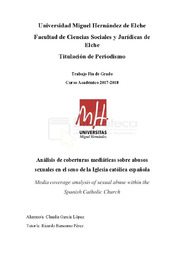Por favor, use este identificador para citar o enlazar este ítem:
https://hdl.handle.net/11000/6925Registro completo de metadatos
| Campo DC | Valor | Lengua/Idioma |
|---|---|---|
| dc.contributor.advisor | Bencomo Pérez, Ricardo | - |
| dc.contributor.author | García López, Claudia | - |
| dc.contributor.other | Departamentos de la UMH::Ciencias Sociales y Humanas | es |
| dc.date.accessioned | 2021-01-19T16:53:39Z | - |
| dc.date.available | 2021-01-19T16:53:39Z | - |
| dc.date.created | 2018-06 | - |
| dc.date.issued | 2021-01-19 | - |
| dc.identifier.uri | http://hdl.handle.net/11000/6925 | - |
| dc.description.abstract | Los abusos sexuales son una de las más absolutas degradaciones de los derechos individuales que conviven en la sociedad actual desde incontables años atrás. El marco de actuación casi en su totalidad, deriva de una situación de confianza establecida entre víctima y abusador. Un rol de supremacía que convierte esa credulidad en vulnerabilidad por parte del damnificado, arma que utiliza el sujeto que se propasa para obtener sus fines. Una de las más extremas ramificaciones de este problema se desenvuelve en el seno de la que podría considerarse, la institución más poderosa del mundo: la Iglesia. Su alcance y autoridad universal complica la información y documentación de casos, la erradicación de los abusos y la búsqueda de justicia. El silencio de las víctimas, que en su totalidad son menores, y el derivado de los medios de comunicación hace prácticamente imposible establecer unas estadísticas exactas que conciencien y sean un reflejo de realidad. Según apuntan las investigaciones de The nature and scope of sexual abuse of minors by catholic priest and deacons in the united states 1950-2002 (John jay college of criminal justice : 2004 : 58), uno de cada tres sacerdotes denunciados son declarados culpables, pero solo el 3% adquiere una pena de prisión. Esa es la realidad. El objetivo de esta investigación es analizar la cobertura mediática española sobre el caso “Romanones”, uno de los más conocidos en cuanto a abusos sexuales en el seno de la Iglesia Católica, barajando la hipótesis de que la ideología de un medio es dependiente del tratamiento de las informaciones del mismo. La pesquisa de un grupo de periodistas de The Boston Globe que posteriormente inspiró la película “Spotlight” marcó un antes y un después en la mediatización de casos de abusos sexuales en la Iglesia. Es un claro ejemplo del descubrimiento de una red de corrupción ética que había sostenido un abismo de silencio durante décadas. Centenares de curas de todo el mapa aparecieron como culpables de abusos a menores, entre los cuales se conocieron dos casos en España. Como consecuencia se inició el eco de las víctimas y el derivado de la sociedad, poniendo los límites que nunca se habían marcado. No hace falta un gran medio para mediatizar una historia, solo uno dispuesto a contarla. | es |
| dc.description.abstract | Sexual abuse is one of the most degrading violations of human rights that has existed in today's society for many years o for countless years. The framework of action almost entirely derives from a situation of trust established between victim and abuser. A role of supremacy that turns that credulity into vulnerability on the part of the victim, weapon that the subject that is passed uses to obtain his ends. One of the most extreme ramifications of this problem is in the bosom of what could be considered, the most powerful institution in the world: the Church. Its scope and universal authority complicates the information and documentation of cases, the eradication of abuses and the search for justice. The silence of the victims, who are minors, and that derived from the media makes it practically impossible to establish accurate statistics that raise awareness and reflect reality. According to the research of The nature and scope of sexual abuse of minors by Catholic priests and deacons in the united states 1950-2002 (John Jay College of Criminal Justice: 2004: 58), one of every three priests denounced are found guilty, but only 3% acquire (sin s) a prison sentence. That´s the reality. The objective of this research is to analyze the Spanish media coverage of the case "Romanones", which is one of the most well known or which is one of the most infamous in terms of sexual abuse within the Catholic Church, considering the hypothesis that the ideology of a medium is dependent on the treatment of the information of the same. The research of a group of journalists from The Boston Globe that later inspired the film "Spotlight" marked a turning point in the mediatization of cases of sexual abuse in the Church. It is a clear example of the discovery of a network of ethical corruption that had sustained an abyss of silence for decades. Hundreds of priests from all over the world were found guilty of child abuse, among which two cases were reported in Spain. As a consequence, the echo of the victims and the derivative of society began, setting the limits that had never been set. It does not take a great medium to mediate a story, only one willing to tell it. | es |
| dc.format | application/pdf | es |
| dc.format.extent | 41 | es |
| dc.language.iso | spa | es |
| dc.rights | info:eu-repo/semantics/openAccess | es |
| dc.subject | Abusos | es |
| dc.subject | España | - |
| dc.subject | Ideología | - |
| dc.subject.other | CDU::0 - Generalidades.::070 - Periódicos. Prensa. Periodismo. Ciencias de la información | es |
| dc.title | Análisis de coberturas mediáticas sobre abusos sexuales en el seno de la Iglesia católica española | es |
| dc.title.alternative | Media coverage analysis of sexual abuse within the Spanish Catholic Church | es |
| dc.type | info:eu-repo/semantics/bachelorThesis | es |

Ver/Abrir:
GARCÍA LÓPEZ, CLAUDIA.pdf
1,06 MB
Adobe PDF
Compartir:
 La licencia se describe como: Atribución-NonComercial-NoDerivada 4.0 Internacional.
La licencia se describe como: Atribución-NonComercial-NoDerivada 4.0 Internacional.
.png)